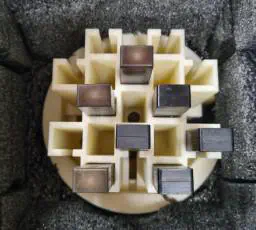Magnetic Sensors

Magnetic sensors are the methods used, by which biomagnetism occurs. Within the University of São Paulo, in Ribeirão Preto, there are:
MCG (Magnetocardiography)
It is a non-invasive technique that records the magnetic fields that are produced from the electrical current of the heart, using magnetometers. The magnetic field produced by the heart is extremely weak (about 10-10 T), being much lower than the intensity of the Earth’s magnetic field (10-5 T) and the level of magnetic noise in urban areas (10-7 T). Therefore, it is very difficult to measure the cardiac magnetic field.
Opposite to other physiological study techniques, such as magnetic resonance imaging or ultrasound, MCG does not emit magnetic fields or energy, it only detects the magnetic fields intrinsically generated by the electrical activity of the heart (Malmivuo & Plonsey, 1995). Baule and McFee, in 1963, were the first to record these magnetic fields, using some copper coils in an open field. They got a wave similar to the electrocardiogram and called it a magnetocardiogram.
MCG has been used in our group’s research for studies, with adult patients of both sexes and also fMCG, with pregnant women from the twelfth week of pregnancy.
Magnetocardiography is a safe method for diagnosing cardiac arrhythmias in adults and fetuses. However, due to the high cost and complexity of SQUID equipment, its application has been limited. Recently, Optical Pumping Magnetometers have emerged as a more affordable and simplified alternative. The development of these devices made it possible to install the first OPM system inside a cylindrical shield.de mu-metal, in the Biomagnetism laboratory at the University of São Paulo in Ribeirão Preto. This marks a significant advance in Brazil and Latin America. The goal is to make GCM more accessible in hospitals and clinics, providing more accurate diagnoses and early treatments.
MGG (Magnetogastrography)
Magnetogastrography (MGG) is a promising technique for studying gastric motility, offering a non-invasive and more accurate alternative to traditional methods such as manometry and electrogastrography. However, MGG is still not widely used due to the high cost and complexity of the required equipment. With the recent development of optically pumped magnetometers (OPMs), there has been a significant reduction in the cost and complexity of biomagnetic systems, making MGG more accessible. The installation of the first OPM system in a shielded chamber in Brazil, at the University of São Paulo, provides a unique opportunity to explore this technology and its application in the study of gastric motility. This project aims to develop and validate the MGG technique using OPMs, with the goal of improving the diagnosis of gastric disorders in a non-invasive manner. The implementation of this technology could lead to faster, more accurate, and more comfortable diagnoses, as well as pave the way for its adoption in hospitals and clinics, benefiting patients with gastrointestinal dysfunctions.